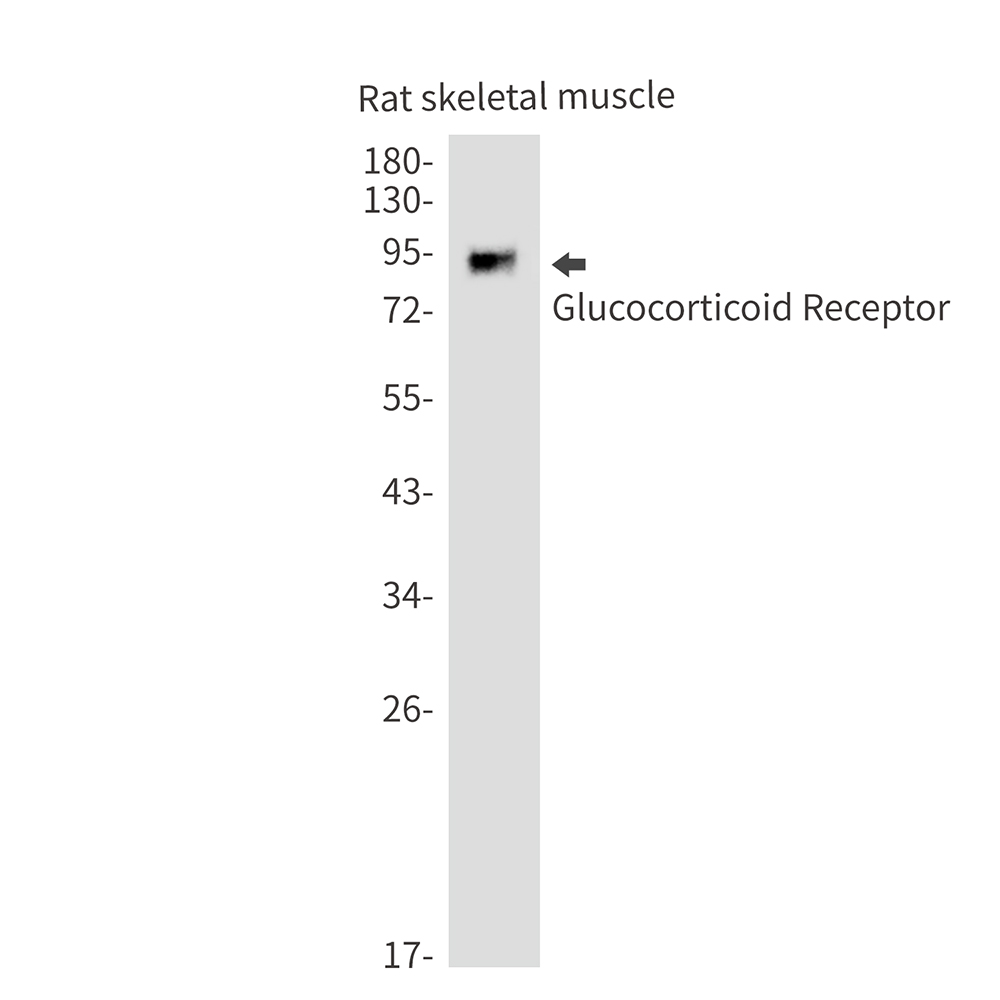Glucocorticoid Receptor Rabbit mAb
- SPECIFICATION
- CITATIONS
- PROTOCOLS
- BACKGROUND

Application
| WB, ICC |
|---|---|
| Primary Accession | P06537 |
| Reactivity | Human, Mouse, Rat |
| Host | Rabbit |
| Clonality | Monoclonal Antibody |
| Calculated MW | 87164 Da |
| Gene ID | 14815 |
|---|---|
| Other Names | Nr3C1 |
| Dilution | WB~~1/500-1/1000 IF~~1/50-1/200 |
| Format | Liquid |
| Name | Nr3c1 |
|---|---|
| Synonyms | Grl, Grl1 |
| Function | Receptor for glucocorticoids (GC). Has a dual mode of action: as a transcription factor that binds to glucocorticoid response elements (GRE), both for nuclear and mitochondrial DNA, and as a modulator of other transcription factors. Affects inflammatory responses, cellular proliferation and differentiation in target tissues. Involved in chromatin remodeling (PubMed:10678832). Plays a role in rapid mRNA degradation by binding to the 5' UTR of target mRNAs and interacting with PNRC2 in a ligand-dependent manner which recruits the RNA helicase UPF1 and the mRNA-decapping enzyme DCP1A, leading to RNA decay (By similarity). Could act as a coactivator for STAT5- dependent transcription upon growth hormone (GH) stimulation and could reveal an essential role of hepatic GR in the control of body growth (PubMed:15037546). |
| Cellular Location | Cytoplasm. Nucleus Mitochondrion {ECO:0000250|UniProtKB:P04150}. Cytoplasm, cytoskeleton, spindle {ECO:0000250|UniProtKB:P04150}. Cytoplasm, cytoskeleton, microtubule organizing center, centrosome {ECO:0000250|UniProtKB:P04150}. Chromosome. Nucleus, nucleoplasm. Note=After ligand activation, translocates from the cytoplasm to the nucleus (PubMed:11278753). The hormone-occupied receptor undergoes rapid exchange between chromatin and the nucleoplasmic compartment (PubMed:10678832). In the presence of NR1D1 shows a time-dependent subcellular localization, localizing to the cytoplasm at ZT8 and to the nucleus at ZT20 (PubMed:27686098) Lacks this diurnal pattern of localization in the absence of NR1D1, localizing to both nucleus and the cytoplasm at ZT8 and ZT20 (PubMed:27686098). Upon dexamethasone binding associates with the glucocorticoid response elements of target genes (PubMed:30698747) [Isoform 3]: Nucleus. Cytoplasm Note=Expressed predominantly in the nucleus with some expression also detected in the cytoplasm. |
| Tissue Location | Expressed in spleen, kidney and liver (PubMed:20660300). Expressed in a circadian manner in the liver (PubMed:27686098). |

Thousands of laboratories across the world have published research that depended on the performance of antibodies from Abcepta to advance their research. Check out links to articles that cite our products in major peer-reviewed journals, organized by research category.
info@abcepta.com, and receive a free "I Love Antibodies" mug.
Provided below are standard protocols that you may find useful for product applications.
If you have used an Abcepta product and would like to share how it has performed, please click on the "Submit Review" button and provide the requested information. Our staff will examine and post your review and contact you if needed.
If you have any additional inquiries please email technical services at tech@abcepta.com.













 Foundational characteristics of cancer include proliferation, angiogenesis, migration, evasion of apoptosis, and cellular immortality. Find key markers for these cellular processes and antibodies to detect them.
Foundational characteristics of cancer include proliferation, angiogenesis, migration, evasion of apoptosis, and cellular immortality. Find key markers for these cellular processes and antibodies to detect them. The SUMOplot™ Analysis Program predicts and scores sumoylation sites in your protein. SUMOylation is a post-translational modification involved in various cellular processes, such as nuclear-cytosolic transport, transcriptional regulation, apoptosis, protein stability, response to stress, and progression through the cell cycle.
The SUMOplot™ Analysis Program predicts and scores sumoylation sites in your protein. SUMOylation is a post-translational modification involved in various cellular processes, such as nuclear-cytosolic transport, transcriptional regulation, apoptosis, protein stability, response to stress, and progression through the cell cycle. The Autophagy Receptor Motif Plotter predicts and scores autophagy receptor binding sites in your protein. Identifying proteins connected to this pathway is critical to understanding the role of autophagy in physiological as well as pathological processes such as development, differentiation, neurodegenerative diseases, stress, infection, and cancer.
The Autophagy Receptor Motif Plotter predicts and scores autophagy receptor binding sites in your protein. Identifying proteins connected to this pathway is critical to understanding the role of autophagy in physiological as well as pathological processes such as development, differentiation, neurodegenerative diseases, stress, infection, and cancer.




